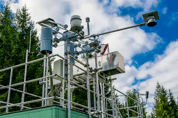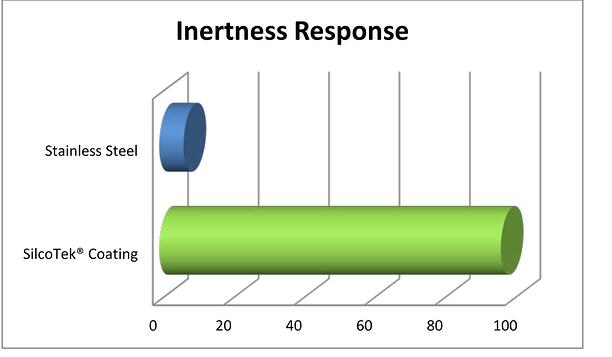
Analysts have conquered measuring at part-per-million, part-per-billion, and even part-per-trillion levels, but can they conquer part-per-quadrillion measurement? PPQ is coming and SilcoTek coatings can help achieve the goal.
What is 1 part-per-quadrillion? Well let's say it's smaller than small. PPQ is a scale that's tough to imagine. The old analogy used to compare something to a drop in a lake or a drop in the proverbial bucket. I wish ppq measurement were that easy! We'll use a measurement analogy discussed on the Australian National Measurement Institute website when comparing part-per-trillion with part-per-quadrillion. The ANMI site noted that 1ppt is the equivalent to traveling a distance of one cm in a trip 600 times around the Earth. So one ppt is a small step of a very long trip. But ppq puts that small measurement to shame. One ppq is the equivalent of travelling only 0.15mm on a trip to the Sun! That's a sobering idea of how small 1 ppq is and how challenging ppq analysis can be. Numerically a quadrillion tallies to 1 part per 1,000,000,000,000,000. Ugh that's a lot of zeros. In this blog post we discuss how to achieve ppq performance in the lab.
|
In this blog post you will learn:
- Applications where part-per-quadrillion analysis is needed.
- How to detect at ppq levels.
- How an inert surface is needed for ppq analysis.
- Keys to achieving ppq detection levels.
|
Why do I care about part-per-quadrillion analysis?
There are some nasty chemicals out there that even a small amount of can be dangerous, deadly, or can impact the quality of products. When measuring part-per-billion levels of contamination, the environment, human health, and product quality improved. PPT measurement moved the bar forward in helping to detect and manage pervasive contaminants that led to chronic problems in health, pollution, and product yield. The same will be true when managing and realizing ppq analysis benefits. There are several areas of analysis even now that benefit from having the capability of consistent and reliable part-per-quadrillion analysis. Some examples are:
- Air quality monitoring. Sometimes it can be difficult to detect air pollutants especially when measuring from long distances. Having the ability to detect target contaminants at low levels give analysts the ability to identify sources of contamination and target remediation efforts.
- Soil contamination and dioxin detection. Dioxins are extremely dangerous carcinogens even at trace levels. The lower the detection level the safer our communities will be.
- PFCs, PFOA, and PFOS and other potential cancer causing chemicals. Many can be found in our environment at ppt and ppq levels.
- Adulterants in high purity gas. High purity gasses are used in many industries. Many businesses depend on ultra pure gas to achieve product yields needed to achieve profitable production levels. Semiconductor manufacturing for example is moving to 14 nm production and even smaller node architecture. At that level, even small amounts of contamination can impact product yield. Recent enhancements in detection capability has improved detection of SF6 in ultra-pure Ar to 750 ppq.
- Hazardous gas detection. Hazardous gasses like HF can be harmful even at very low levels. Low level detection improves systems meant to alert workers in refineries and chemical process industries.
- Explosive detection. Ultra low level explosive detection has many applications in homeland security and defense. Reliable ppq detection will help to improve airport screening and can improve forensic analysis.
- Chemical agent detection. Improved chemical agent detection can help military organizations find "bad actors" using chemical agents at greater range.
How to detect at ppq levels?
 Realizing the human health, environmental, and business benefits of ppq detection takes effort. It's not like you can turn the ppt "volume knob" up to 11 and get good results. It takes improved systems and techniques to achieve reliable ppq detection.
Realizing the human health, environmental, and business benefits of ppq detection takes effort. It's not like you can turn the ppt "volume knob" up to 11 and get good results. It takes improved systems and techniques to achieve reliable ppq detection.
Types of detection systems vary and include:

One Key to Achieving ultra low level detection
Robust equipment design and meticulous sample preparation play a large role in achieving ultra low level detection limits. Equipment costs can run into hundreds of thousands of dollars for some instruments. All that expensive equipment won't achieve results without improving the sample flow path. It's vital to develop highly robust procedures based on well researched methods. One key area that must be addressed and managed? Adsorption and chemical interaction of the flow path surface with the target analyte. Without thoroughly managing flow path inertness it will be unlikely that you'll achieve ppq or even ppt, or ppb level results. Some tips for managing the flow path are:
- Understand the reactivity of each component material in the flow path for the target test regime. A material capable of ppm analysis may not be appropriate when testing at ppq levels.
- Prepare the surface using non reactive chemicals that will not leave trace contaminants.
- Focus on sample prep and adopt a rigorous method.
- Use proven non-reactive materials in the flow path. Don't forget to test & select sealing materials that will not adsorb or react with test analytes.
- Select an inert material like SilcoNert® to prevent interaction with the test analyte. SilcoNert is proven in part-per-quadrillion applications. Read about the test here. SilcoNert does not interact with reactive chemicals, allowing nearly all the analyte to reach the detector and improving response dramatically when testing trace compounds at ppq levels.

Have a burning question about our coating. Go to our FAQ page, or ask the experts.


 Realizing the human health, environmental, and business benefits of ppq detection takes effort. It's not like you can turn the ppt "volume knob" up to 11 and get good results. It takes improved systems and techniques to achieve reliable ppq detection.
Realizing the human health, environmental, and business benefits of ppq detection takes effort. It's not like you can turn the ppt "volume knob" up to 11 and get good results. It takes improved systems and techniques to achieve reliable ppq detection. 


